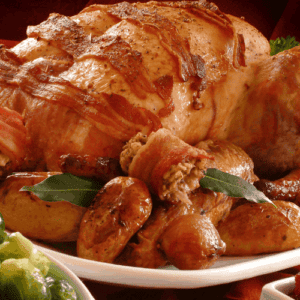
Roasted Turkey Recipe
Make this the year you stun your guests with the epitome of flavor and tenderness with our Gordon Ramsay-inspired turkey recipe. A symphony of lemon, parsley, garlic, and luscious herb butter creates a roast turkey.
Ingredients
- 1 turkey
- 2 onions, peeled and halved
- 1 lemon, halved
- 1 head garlic halved horizontally
- 6 bay leaves
- 8 slices smoked streaky bacon
- 1 2/3 cups (3 1/2 sticks) butter at room temperature
- 1 tablespoon olive oil
- 2 small lemons, zest and juice finely grated
- 3 cloves Garlic, peeled and crushed
- 1 small bunch flat leaf parsley, leaves only, chopped
- sea salt u0026 freshly ground black pepper
- additional olive oil to drizzle
For Gravy
- 4 tablespoons unsalted butter (or use the equivalent amount of fat from meat drippings if available)
- 1/4 cup all-purpose flour
- 2 cups broth (beef, chicken, or vegetable, depending on your preference or what you're serving it with)
- Salt, to taste
- Black pepper, to taste
- Optional: herbs and spices like thyme, rosemary, garlic powder, etc., to taste
Instructions
- Preheat the oven to 428°F.
- Combine the butter, olive oil, finely grated lemon zest and juice, crushed garlic, and chopped parsley in a large bowl.
- Remove the turkey giblets, season the turkey cavity with salt and pepper, then stuff it with the onions, lemon, garlic halves, and 2 bay leaves.
- Gently loosen the skin on the turkey's breast and legs while keeping it intact. Distribute half the flavored butter in the spaces under the skin and gently massage it from the outside to spread it evenly over the meat. Insert the remaining bay leaves under the skin.
- Place the turkey, breast side up, in a large roasting pan. Spread the remaining butter over the skin, season well with salt and pepper, and drizzle with olive oil.
- Roast the turkey in the preheated oven for 10–15 minutes. Then take the pan out of the oven, baste the bird with the pan juices, lay the bacon rashers over the breast to keep it moist and baste again. Lower the oven to 350°F and cook for about 2½ hours, basting occasionally.
- To test whether the turkey is cooked, insert a skewer into the thickest part of the leg to see if the juices run clear, not pink. Check about 30 minutes before the calculated roasting time is up. If the juices are pink, roast for 15 minutes, then check again.
- When the turkey is cooked, transfer it to a warmed platter and let it rest in a warm place for at least 45 minutes before carving. Remove the bay leaves from under the skin before serving. Serve with hot gravy, stuffing and side dishes of your choice.
For Gravy
- Melt the Butter: Melt the unsalted butter in a saucepan over medium heat. If you're using meat drippings, heat them instead of butter.
- Make the Roux: Whisk in the flour and continue stirring to create a roux. Cook for a minute or two until the mixture is lightly browned and smells slightly toasted. This will help thicken the gravy and remove the raw flour taste.
- Add Liquid Slowly: Add the broth to the roux, whisking constantly to prevent lumps from forming. Pour slowly and keep the whisk moving to ensure a smooth consistency.
- Season: Add salt, black pepper, and any other desired herbs or spices. Stir well. If you're using meat drippings, be cautious with the salt, as drippings can already be quite salty.
- Simmer: Bring the gravy to a simmer and cook until it thickens to your desired consistency. Keep stirring occasionally.
- Adjust and Serve: Taste the gravy and adjust the seasoning if necessary. Once the gravy is thick and flavorful, remove it from the heat.
- Strain (Optional): For an extra smooth gravy, strain it through a fine-mesh sieve to remove any possible lumps.
- Serve the gravy hot over mashed potatoes, roast meats, or any other dish that could use some good, flavorful gravy.
Video
Notes
Adapted from Gordon Ramsay's Cookalong Live TV Show.